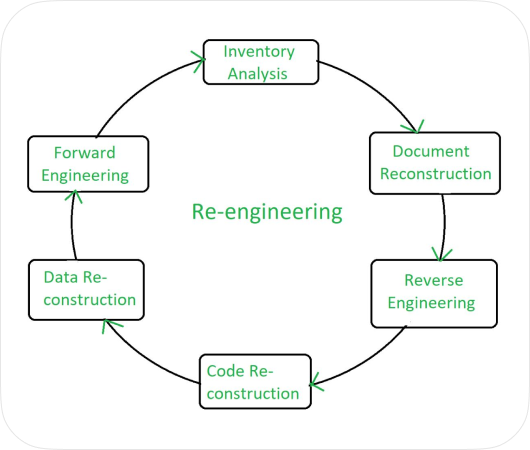Re-Engineering

Analysis review systems available artifacts, requirements and existing software documentation
Evaluate Available Artifacts
evaluate and examine issues in system which requires re-engineering
Options & Deliverables
Deliverables of the re-engineering activities and provide options to the stakeholders.
Analysis
The analysis step is crucial as it lays the foundation for understanding the current state of the software and identifying areas for improvement.
Objectives of the Analysis Step are to Understand the Current System (Gain a comprehensive understanding of the existing software, including its architecture, components, and functionality), Identify Issues and Limitations (Pinpoint the problems, inefficiencies, and limitations within the current system), Gather Requirements for Improvement (Collect requirements and expectations from stakeholders for the re-engineered system) and Evaluate Feasibility (Assess the feasibility of various re-engineering options and strategies). The initial phase where requirements are gathered, and the scope of the project is defined. This involves understanding the client’s needs, identifying the problem to be solved, and determining the functional and non-functional requirements of the software.


Evaluate Available Artifacts
Review the existing source code to understand its structure, logic, and dependencies. This may involve code walkthroughs and static code analysis tools.
Examine the current architecture to identify strengths, weaknesses, and areas for potential restructuring.
Evaluate the existing functionality to understand what the software currently does and how it aligns with user needs.
Gather and review all existing documentation, including design documents, user manuals, and maintenance logs.
Conduct interviews and surveys with stakeholders, including users, developers, and business leaders, to gather their input on current issues and desired improvements.
Collect detailed requirements for the re-engineered system, focusing on performance, maintainability, scalability, and new features.
Conduct performance tests to identify bottlenecks and areas where the software does not meet performance expectations.
Evaluate the software for code quality, including readability, modularity, and adherence to coding standards. Use metrics such as cyclomatic complexity, code coverage, and technical debt.
Identify and document technical debt, which includes shortcuts taken in the original development that may now hinder performance, scalability, or maintainability.
Analyze the impact of technical debt on the software’s current and future performance.
Map out all internal and external dependencies of the software, including libraries, frameworks, and third-party services.
Ensure compatibility with current operating systems, hardware, and other relevant systems.
Identify potential risks associated with re-engineering, such as data loss, downtime, or integration issues.
Develop strategies to mitigate identified risks, ensuring a smoother re-engineering process.
Perform a cost-benefit analysis to determine the financial viability of re-engineering the software compared to other options such as replacing or decommissioning it.
Evaluate the resources (time, budget, personnel) required for the re-engineering effort.
Based on the analysis, prioritize the tasks and components that need re-engineering.
Develop a detailed roadmap and timeline for the re-engineering project, outlining phases, milestones, and deliverables.
Options & Deliverables
A comprehensive report detailing the findings from the analysis, including system documentation, identified issues, and stakeholder requirements.
A strategic plan outlining the re-engineering process, including objectives, tasks, timelines, resources, and risk mitigation strategies.
Documentation of the feasibility study, including cost-benefit analysis and resource assessment.
A detailed specification of the requirements for the re-engineered system, derived from stakeholder consultations and analysis findings.
By thoroughly conducting the analysis step, we ensure that the re-engineering process is well-informed, targeted, and aligned with stakeholder needs and technical requirements. This sets the stage for a successful re-engineering project that delivers a more efficient, maintainable, and scalable software system.

